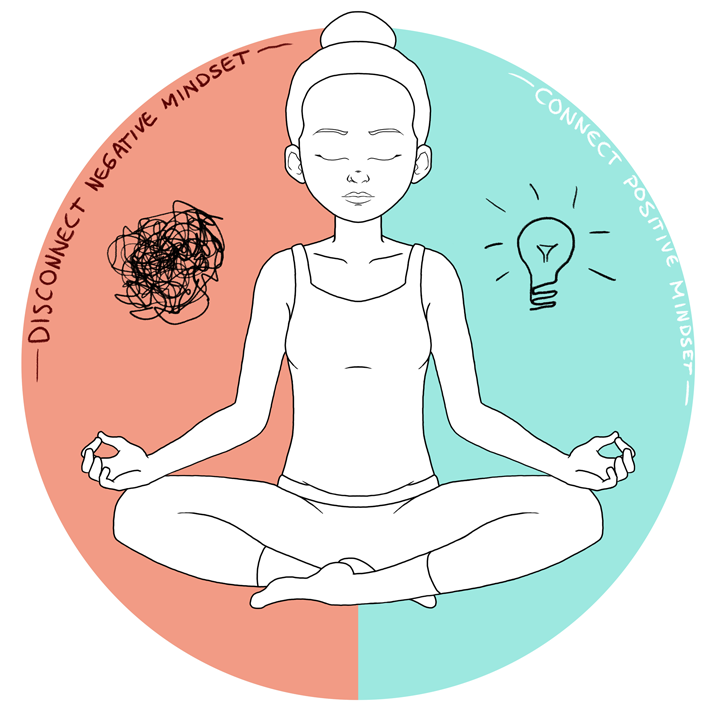The test day is finally here, and you have done your part: planned, prepared, and practiced hard. Yet, you feel uneasy — your hands are sweaty, your stomach feels funny, or worse, you see the questions and your brain freezes instantly. If you can relate to any of the above reactions to testing, then you are not alone. Ten million children in North America, alone, face test anxiety and the numbers are only increasing1.
Some amount of test anxiety is normal and even beneficial. However, when the anxiety consistently interferes with your test-taking ability and impairs your physical, mental, and emotional well-being, then it’s time to take action.
According to cognitive and behavioral science studies, several types of anxiety disorders, including test-related anxieties, are triggered by repetitive negative thinking. But, the good news is that such negative thoughts can be treated or minimized by training our brain to think positively, thereby relieving the symptoms of anxiety2.
To cultivate a positive-thinking mindset, first, we need to know the negative attitudes that underlie test-related anxieties. Based on an in-depth study on the effects of standardized testing on students’ well-being 3 and viewpoints on digital platforms, like Quora and Reddit, some common negative mindsets that are associated with test anxiety are:
- Tests make me think, “I am dumb,” or “I am stupid.”
- Tests decide my life’s destiny.
- Tests with so many rules stress me out and make me feel unprepared.
- Tests do not add any value to life beyond academia, so why should I care?
To overcome or minimize test-related anxieties, students should be able to truly engage in tests and the test-taking process. You can train your brain to cultivate a positive mindset so that the tests and test-takers are in harmony with each other.

Negative Mindset ———————–Test——————Fearful and anxious test-taking
(Fear, Suspicion, (Disconnect)
Lack of purpose, Self-doubt)
Positive Mindset ————————-Test——————-Mindful and effective test-taking
(Effort, Trial and Error, (Connect)
Stretch, Value)
Read along to find out what comprises a positive mindset and how the four winning mindsets can help you engage and overcome test anxiety.
1. Effort Mindset
Negative Mindset: If I don’t do well on tests, then I am stupid or dumb.
Positive Mindset: If I don’t do well on tests, then I need to put in more effort.
If poor test performance makes you feel unintelligent or less smart, then, according to Carol Dweck, the author of Mindset: The New Psychology of Success4, you are thinking with a fixed mindset. With the fixed mindset, you believe that your ability to perform well is dependent on your inborn intelligence and smartness, and, therefore, you cannot control or change the results. That is, you give too much importance to intelligence and talent.
However, using real-life examples and scientific data, the author shows that you can turn “a failure into a gift,” simply by shifting the focus to learnable qualities, like effort and hard work. This positive mindset teaches you that, through learning and persistent practice, you are in control of the outcome of tests.
What the author refers to as a growth mindset (or what students can remember as an effort mindset) can be summarized as follows:
Emphasizing effort gives a child a variable that they can control. They come to see themselves as in control of their success. Emphasizing natural intelligence takes it out of the child’s control, and it provides no good recipe for responding to a failure.
— Carol Dweck
So, next time there is a test coming up, or you are staring at scores with which you are not happy, take charge, study hard, and set an intention to put effort towards improving your knowledge and skills, consistently. Imagine your brain making strong new connections every day as you plow forward patiently, not to win, but to learn and improve. Before you know it, you will not only be winning, but having fun doing it.
| Fixed Mindset | Effort Mindset |
| Value is placed on innate qualities like intelligence and talent.
Poor scores = “I am not smart.” |
Value is placed on learnable qualities, like effort and hard work.
Poor scores = “I need to put in more effort.” |
| Close-minded
Poor scores = Permanent setback |
Open-minded
Poor scores = Where and how can I improve? |
| Negative self-talk
“I am no good.” |
Positive self-talk
“I can improve with effort and time.” |
| Poor scores encourage frustration, shame, and a “quitting” mentality. | Poor scores encourage hard work, resilience, and patience. |

2. Trial and Error Mindset
Negative Mindset: Every test decides if I will succeed or fail in life.
Positive Mindset: Every test helps me learn by trial and error in a low-stake environment.
The link between test anxiety and high-stakes standardized testing is becoming loud and clear. Students increasingly believe that their performance on every single test, assessment, or quiz carries life-altering consequences; thus, there is no room for any error. Such high expectations of perfectionism are bound to increase performance-related anxiety and fear.
A trial and error mindset, on the other hand, will give you a wide berth to commit mistakes and learn from them. With this approach, you will be able to use the outcome of the test process to assess challenges, strengthen performance, and narrow gaps in learning. And even if you fail, the low-stakes failure will open up conversations, build resilience and confidence, and prepare better for future assessments5.
To implement trial and error practice effectively, you must protect your brain from the effects of attaching powerful labels like “high-stake” to testing. With so much hype and hysteria surrounding tests, students succumb to fear and anxiety, and are, thus, unable to explore, experiment, and learn through mistakes. Remember, according to the Merriam-Webster dictionary, a student is defined as a learner, and school years are a learning phase in one’s life. To bring perspective to labels like “high-stakes”, consider the following five, very different scenarios, all resulting from the single mistake of forgetting to convert pounds to kilograms. Notice how, when viewed in a different context, the high stakes attached to school testing become just a small mistake.
For the 4th grader, it is a loss of a point.
For the 8th grader, it may be a loss of a math placement.
For a high-schooler, it may cost admission into one of several colleges.
For NASA, it was a loss of a $125 million Mars orbiter.
But for healthcare, it’s death by overdose.
With a trial and error mindset, you will be able to treat tests as low-stake learning opportunities as opposed to high-stake life-altering events, replace fear with curiosity, and explore an effective path to success.
3. Stretch Mindset
Negative Mindset: The time pressure and unpredictability of testing make me anxious.
Positive Mindset: I am prepared, and I am capable of more than I think.
The test day is approaching, and you are still collecting, preparing, and, perhaps, cramming until the last moment. Despite your preparatory efforts, you feel you are no match for the trick questions hurled at you in a tiny test window.
According to Scott Sonenshein, the author of Stretch: Unlock the Power of Less — and Achieve More Than You Ever Imagined6, “we routinely overestimate the importance of acquiring resources but even more significantly underestimate our ability to make more out of those we have.”
That is, at some point, we need to close our textbooks, regroup our fundamental resources, stop worrying about what we may have missed, and focus on what we already know. With an attitude of “less is more,” a stretch mindset will help you focus on your strengths rather than your limitations, approach time or knowledge limitation as a constructive challenge, and adapt to any surprises by being resourceful.
Students, while taking tests, have to operate effectively with limited time and resources. According to the author, the stretch mindset will not only help you do better under constraints, but allow you to use the constraints to your advantage in solving problems effectively.
For example, when asked to write an essay within ten minutes, or with a minimum of 200 words, your brain’s responses are heightened, focused, and stretched to unleash creative and critical skills needed to scrape all the available resources to cut the distractions and arrive at the message. The situation will force you to focus on main ideas, use concise language, pick words economically, and write to the point
With the help of a stretch mindset, you will ease your anxieties because you know that your foundation is strong, and you can always build on it. Next time, when you feel less and less prepared as the test day nears, tell yourself that you know more, and you are capable of much more than you think you are.
4. Value-Creation Mindset
Negative Mindset: I don’t understand the purpose of tests. They do not add value beyond academia.
Positive Mindset: Tests help me learn and achieve my dreams.
Value creation may sound like a fancy word used in the business world, but the concept is practical enough to be taught to children. In Japan, schools built on the philosophy of Soka, meaning “value-creating” teach this concept to children as young as 6 years old. The concept is defined as, “the capacity to find meaning, to enhance one’s existence and contribute to the well-being of others, under any circumstance7.”
For a moment, think not of quizzes, tests, or assessments, but of why you are in school. Consider the following questions:
- Do you have a dream or a personal story that inspires you to contribute to the world?
Some possible answers to this question could be:
- “I saw my dog suffer a long and painful journey with arthritis. I want to study hard and find an effective cure so that other dogs do not suffer like my dog.
- “My dream is to send kids on a field trip to Mars. I want to do well in school so that I can join the NASA Mars team and make it possible in the near future.”
- Do you have a specific aim or sense of purpose to do well in school? For example, your aim may be to be a student-athlete in college, or pursue a career in journalism.
All of these answers require a healthy academic performance in school.
If you cultivate a strong sense of purpose or passion to create value personally or globally, then you take charge and self-motivate to work towards the goal. If tests are the means to reach those goals, then you will tackle them, not with anxiety and fear, but with passion and drive.

Conclusion
Tests are not merely periodic checkpoints that evaluate your mastery of the academic content. They are constructive processes that help you learn and accumulate knowledge. The test-taking skills will boost your confidence and prepare you for the testing scenarios that unfold in college, the workplace (job interviews, competency tests), and even help solve problems that arise in your day-to-day life. Therefore, it is crucial to overcome your test anxiety. The four positive mindsets will not only help you embrace tests but turn them into a launchpad to success.
As you practice these mindsets, you will be able to approach tests — not like an anxiety-inducing steep climb to the top of a mountain, bearing the fear that one misstep will take you tumbling down, never to get up again, but like running on wide green pastures, where you let yourself free, get dirty, stumble, and fall many times, only to get up and run again, because it is so much fun!
References:
- American Test Anxiety Association (2010). Accessed April 19, 2021. http://amtaa.org/
- C. Eagleson, S. Hayes, A. Mathews. G. Perman and C.R. Hirsch, “The Power of Positive Thinking: Pathological Worry is Reduced by Thought Replacement in Generalized Anxiety Disorder,” Behavior Research and Therapy 78, (2016): https://doi.org/10.1016/j.brat.2015.12.017
- C. Simpson. Effects of Standardized Testing on Students’ Well-Being. Harvard Graduate School of Education. May 2016. Accessed April 19, 2021. https://projects.iq.harvard.edu/files/eap/files/c._simpson_effects_of_testing_on_well_being_5_16.pdf
- Carol S. Dweck, Mindset: The New Psychology of Success. (New York: Ballantine Books, 2016).
- Scott Warnock, “Frequent, Low-Stakes Grading: Assessment for Communication, Confidence.” Faculty Focus. April 18, 2013. https://www.facultyfocus.com/articles/online-education/online-assessment-grading-and-feedback/frequent-low-stakes-grading-assessment-for-communication-confidence
- Scott Sonenshein, Stretch: Unlock the Power of Less -and Achieve More Than You Ever Imagined. (Harper Business, 2017).
- “What is Value-Creating Education?” Daisaku Ikeda. Accessed April 22, 2021. https://www.daisakuikeda.org/main/educator/edu/edu-03.html























